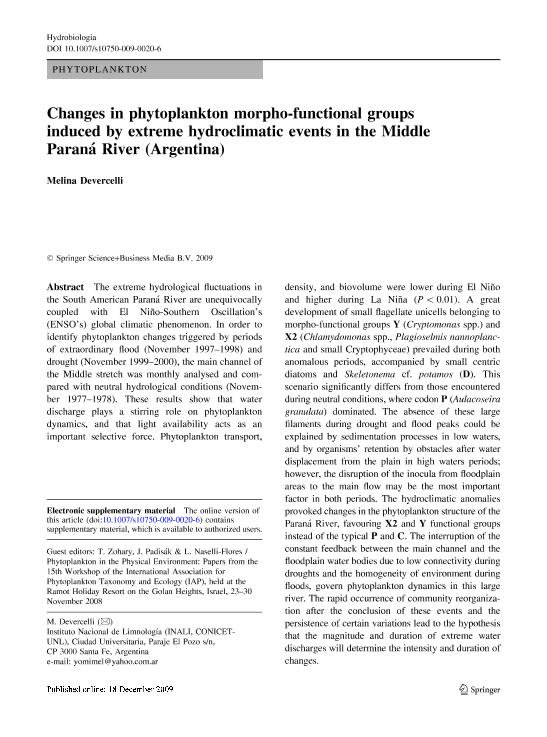Mostrar el registro sencillo del ítem
dc.contributor.author
Devercelli, Melina

dc.date.available
2020-04-22T21:16:22Z
dc.date.issued
2009-12
dc.identifier.citation
Devercelli, Melina; Changes in phytoplankton morpho-functional groups induced by extreme hydroclimatic events in the Middle Paraná River (Argentina); Springer; Hydrobiologia; 639; 1; 12-2009; 5-19
dc.identifier.issn
0018-8158
dc.identifier.uri
http://hdl.handle.net/11336/103371
dc.description.abstract
The extreme hydrological fluctuations in the South American Paraná River are unequivocally coupled with ENSO´s global climatic phenomenon. In order to identify phytoplankton changes triggered by extraordinary flood (November 1997-1998) and drought (November 1999-2000) periods, the main channel of the Middle stretch was monthly analysed and compared with neutral hydrological conditions (November 1977-1978). These results show that water discharge plays a stirring role on phytoplankton dynamics, and that light availability acts as an important selective force. Phytoplankton transport, density and biovolume were lower during El Niño and higher during La Niña (p<0.01). A great development of small flagellate unicells belonging to morpho-functional groups Y (Cryptomonas spp.) and X2 (Chlamydomonas spp., Plagioselmis nannoplanctica and small Cryptophyceae) prevailed during both anomalous periods, accompanied by small centric diatoms and Skeletonema cf. potamos (D). This scenario significantly differs from those encountered during neutral conditions where codon P (Aulacoseira granulata) dominated. The absence of these large filaments during drought and flood peaks could be explained by sedimentation processes in low waters, and by organisms’ retention by obstacles after water displacement from the plain in high waters periods; however, the disruption of the inocula from floodplain areas to the main flow may be the most important factor in both periods. The hydroclimatic anomalies provoked changes in the phytoplankton structure of the Paraná River, favouring X2 and Y functional groups instead of the typical P and C. The interruption of the constant feedback between the main channel and the floodplain water bodies due to low connectivity during droughts and the homogeneity of environment during floods, govern phytoplankton dynamics in this large river. The rapid occurrence of community reorganization after the conclusion of these events and the persistence of certain variations, lead to the hypothesis that the magnitude and duration of extreme water discharges will determine the intensity and duration of changes.
dc.format
application/pdf
dc.language.iso
eng
dc.publisher
Springer

dc.rights
info:eu-repo/semantics/openAccess
dc.rights.uri
https://creativecommons.org/licenses/by-nc-sa/2.5/ar/
dc.subject
POTAMOPLAKTON
dc.subject
FUNCTIONAL GROUPS
dc.subject
LARGE RIVERS
dc.subject
ENSO
dc.subject.classification
Ecología

dc.subject.classification
Ciencias Biológicas

dc.subject.classification
CIENCIAS NATURALES Y EXACTAS

dc.title
Changes in phytoplankton morpho-functional groups induced by extreme hydroclimatic events in the Middle Paraná River (Argentina)
dc.type
info:eu-repo/semantics/article
dc.type
info:ar-repo/semantics/artículo
dc.type
info:eu-repo/semantics/publishedVersion
dc.date.updated
2020-04-21T15:25:57Z
dc.journal.volume
639
dc.journal.number
1
dc.journal.pagination
5-19
dc.journal.pais
Alemania

dc.journal.ciudad
Berlin
dc.description.fil
Fil: Devercelli, Melina. Consejo Nacional de Investigaciones Científicas y Técnicas. Centro Científico Tecnológico Conicet - Santa Fe. Instituto Nacional de Limnología. Universidad Nacional del Litoral. Instituto Nacional de Limnología; Argentina
dc.journal.title
Hydrobiologia

dc.relation.alternativeid
info:eu-repo/semantics/altIdentifier/doi/http://dx.doi.org/10.1007/s10750-009-0020-6
Archivos asociados
